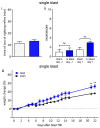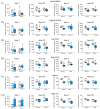Repetitive, but Not Single, Mild Blast TBI Causes Persistent Neurological Impairments and Selective Cortical Neuronal Loss in Rats
- PMID: 37759899
- PMCID: PMC10526452
- DOI: 10.3390/brainsci13091298
Repetitive, but Not Single, Mild Blast TBI Causes Persistent Neurological Impairments and Selective Cortical Neuronal Loss in Rats
Abstract
Exposure to repeated mild blast traumatic brain injury (mbTBI) is common in combat soldiers and the training of Special Forces. Evidence suggests that repeated exposure to a mild or subthreshold blast can cause serious and long-lasting impairments, but the mechanisms causing these symptoms are unclear. In this study, we characterise the effects of single and tightly coupled repeated mbTBI in Sprague-Dawley rats exposed to shockwaves generated using a shock tube. The primary outcomes are functional neurologic function (unconsciousness, neuroscore, weight loss, and RotaRod performance) and neuronal density in brain regions associated with sensorimotor function. Exposure to a single shockwave does not result in functional impairments or histologic injury, which is consistent with a mild or subthreshold injury. In contrast, exposure to three tightly coupled shockwaves results in unconsciousness, along with persistent neurologic impairments. Significant neuronal loss following repeated blast was observed in the motor cortex, somatosensory cortex, auditory cortex, and amygdala. Neuronal loss was not accompanied by changes in astrocyte reactivity. Our study identifies specific brain regions particularly sensitive to repeated mbTBI. The reasons for this sensitivity may include exposure to less attenuated shockwaves or proximity to tissue density transitions, and this merits further investigation. Our novel model will be useful in elucidating the mechanisms of sensitisation to injury, the temporal window of sensitivity and the evaluation of new treatments.
Keywords: blast neurotrauma; blast trauma; blast traumatic brain injury; concussion; functional deficits; repetitive brain injury.
Conflict of interest statement
Dickinson received funding as detailed above and acknowledges the financial support of the Royal British Legion. Rita Campos-Pires was the recipient of a doctoral training award from the Fundação para a Ciência e a Tecnologia, Lisbon, Portugal, and received funding from the Association of Paediatric Anaesthetists of Great Britain and Ireland. Mariia Koziakova was the recipient of a Rector’s PhD Studentship from Imperial College London. Eszter Ujvari is the recipient of an MRC PhD studentship. The other authors declare no competing interests.
Figures










Similar articles
-
[Mild traumatic brain injury and postconcussive syndrome: a re-emergent questioning].Encephale. 2012 Sep;38(4):329-35. doi: 10.1016/j.encep.2011.07.003. Epub 2011 Aug 31. Encephale. 2012. PMID: 22980474 Review. French.
-
Resilience of females to acute blood-brain barrier damage and anxiety behavior following mild blast traumatic brain injury.Acta Neuropathol Commun. 2022 Jun 27;10(1):93. doi: 10.1186/s40478-022-01395-8. Acta Neuropathol Commun. 2022. PMID: 35761393 Free PMC article.
-
Long-term increase in sensitivity to ketamine's behavioral effects in mice exposed to mild blast induced traumatic brain injury.Exp Neurol. 2022 Apr;350:113963. doi: 10.1016/j.expneurol.2021.113963. Epub 2021 Dec 28. Exp Neurol. 2022. PMID: 34968423 Free PMC article.
-
Psychosocial impairment following mild blast-induced traumatic brain injury in rats.Behav Brain Res. 2021 Aug 27;412:113405. doi: 10.1016/j.bbr.2021.113405. Epub 2021 Jun 23. Behav Brain Res. 2021. PMID: 34097900 Free PMC article.
-
Assessing neuro-systemic & behavioral components in the pathophysiology of blast-related brain injury.Front Neurol. 2013 Nov 21;4:186. doi: 10.3389/fneur.2013.00186. Front Neurol. 2013. PMID: 24312074 Free PMC article. Review.
Cited by
-
Blood-Based Lateral-Flow Immunoassays Dipstick Test for Damaged Mitochondrial Electron Transport Chain in Pyruvate Treated Rats with Combined Blast Exposure and Hemorrhagic Shock.J Clin Med. 2025 Jan 24;14(3):754. doi: 10.3390/jcm14030754. J Clin Med. 2025. PMID: 39941423 Free PMC article.
-
Sex-dependent blood-brain barrier alterations following repeated mild blast traumatic brain injury at varying inter-injury intervals.Exp Neurol. 2025 Oct;392:115325. doi: 10.1016/j.expneurol.2025.115325. Epub 2025 May 30. Exp Neurol. 2025. PMID: 40451452
-
Reactive gliosis in traumatic brain injury: a comprehensive review.Front Cell Neurosci. 2024 Feb 28;18:1335849. doi: 10.3389/fncel.2024.1335849. eCollection 2024. Front Cell Neurosci. 2024. PMID: 38481632 Free PMC article. Review.
-
Visual motion hypersensitivity, from spaceflight to Parkinson's disease-as the chiasmatic cistern may be impacted by microgravity together with normal terrestrial gravity-opposition physiology in the brain.Exp Brain Res. 2024 Mar;242(3):521-523. doi: 10.1007/s00221-024-06780-4. Epub 2024 Jan 22. Exp Brain Res. 2024. PMID: 38252144 No abstract available.
-
Repetitive Mild but Not Single Moderate Brain Trauma Is Associated with TAR DNA-Binding Protein 43 Mislocalization and Glial Activation in the Mouse Spinal Cord.Biomedicines. 2025 Jan 16;13(1):218. doi: 10.3390/biomedicines13010218. Biomedicines. 2025. PMID: 39857801 Free PMC article.
References
-
- Maas A.I.R., Menon D.K., Adelson P.D., Andelic N., Bell M.J., Belli A., Bragge P., Brazinova A., Buki A., Chesnut R.M., et al. Traumatic brain injury: Integrated approaches to improve prevention, clinical care, and research. Lancet Neurol. 2017;16:987–1048. doi: 10.1016/S1474-4422(17)30371-X. - DOI - PubMed
-
- DoD_Worldwide_Numbers_for_TBI. [(accessed on 31 July 2023)]. Available online: https://dvbic.dcoe.mil/dod-worldwide-numbers-tbi.
Grants and funding
LinkOut - more resources
Full Text Sources
Research Materials

